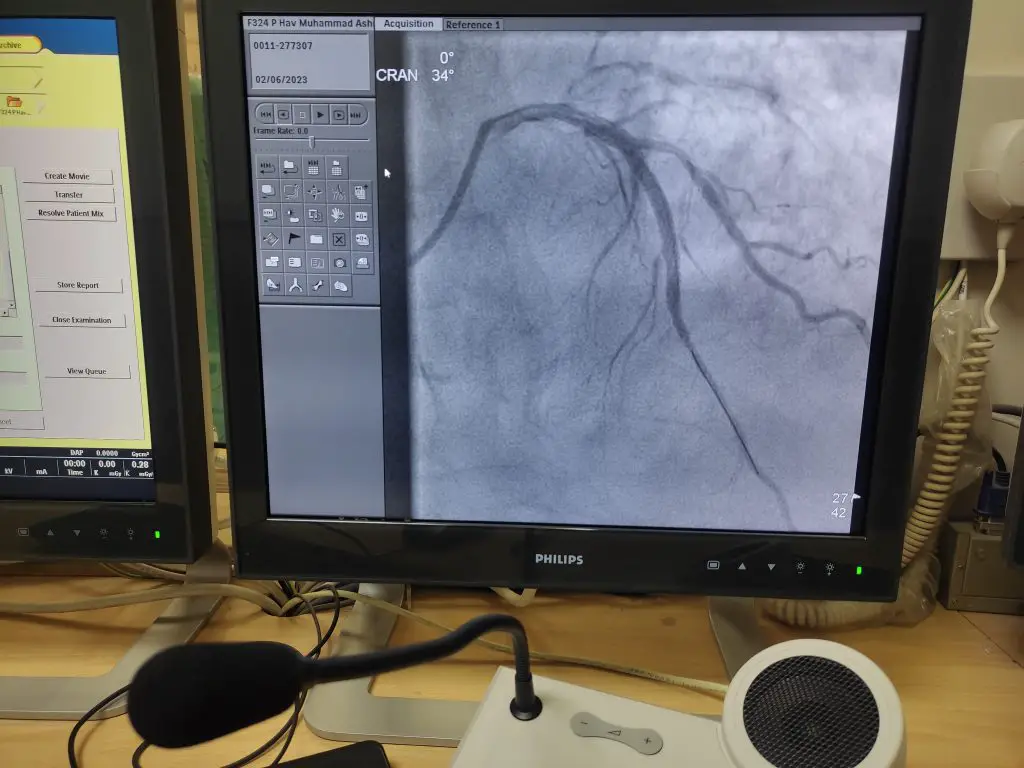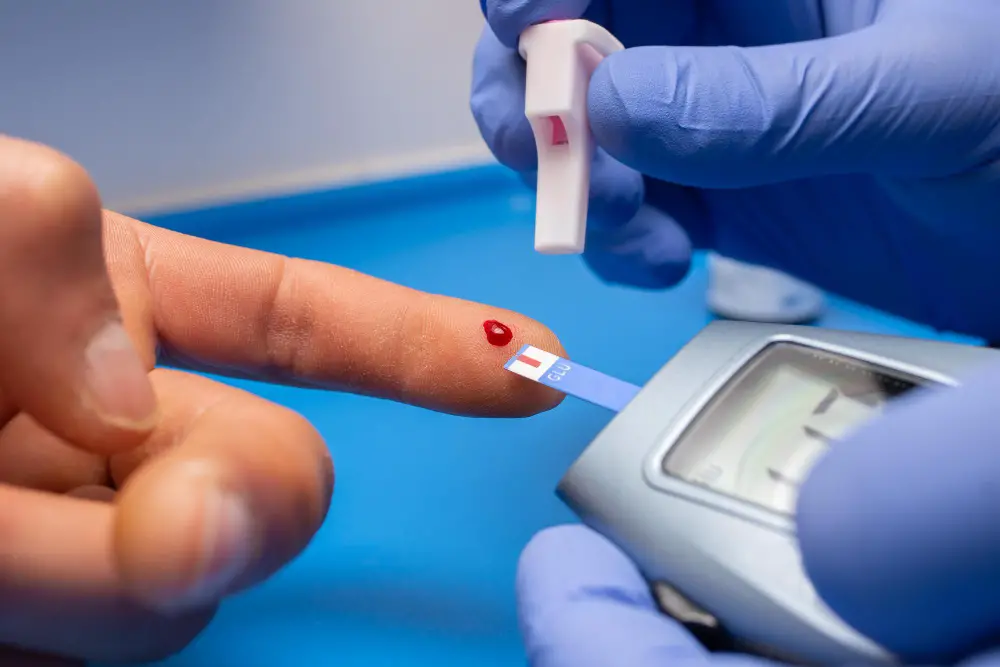
Living With a 100% Blocked LAD Artery
-
- Dr. Junaid Arshad
- February 5, 2023
- 0 comments
Table of Contents
Can You Live With a 100% Blocked LAD Artery?
Yes, a person can live with a 100% blocked LAD artery but that’s more likely in the case of chronic occlusion. When the blockage occurs acutely, it causes a massive heart attack called Anterior wall MI.
In the case of acute 100% occlusion of the LAD artery i.e anterior wall MI, the mortality is highest of all other infarcts.
In case of chronic disease, the statistics are different and survival is better.
100% blockage of an artery that occurs chronically is called chronic total occlusion(CTO).
Collateral vessels are small newly formed vessels that develop from nearby unobstructed arteries & supply blood to the heart muscle affected by the CTO. Hence the collateral vessels protect from getting a heart attack but the patient may experience anginal pain.
Studies have shown that CTO is present in 20% of the patients that undergo coronary angiography.[3]
According to American Heart Association Revascularization guidelines published in 2021, patients having 100% occluded arteries (i.e. CTO) can have a good quality of life on medical therapy and may need angioplasty or bypass operation if they experience anginal pain despite medication.[4]
LAD Artery Blockage Symptoms
The Left Anterior Descending (LAD) coronary artery supplies blood to the front and left side of the heart. Blockages in this artery can cause symptoms such as:
#1. Chest pain or angina – a pressure-like or squeezing sensation in the chest
#2. Shortness of breath
#3. Fatigue
#4. Rapid or irregular heartbeat
#5. Lightheadedness or dizziness
It’s important to note that not all individuals with LAD artery blockages will experience symptoms, and in some cases, symptoms may not appear until the blockage is severe.
Diabetic patients may not experience any significant symptoms.
Can LAD Blockage Be Reversed?
Yes, it can be reversed.
The reversal of LAD (Left Anterior Descending) artery blockages depends on the cause and severity of the blockage.
In some cases, lifestyle changes and medications may help to improve blood flow through the artery and reduce the blockage.
However, in more severe cases, procedures such as angioplasty with stenting or coronary artery bypass graft (CABG) surgery may be necessary to restore blood flow to the heart.
It’s important to consult a doctor who can assess the extent of your blockage and recommend the best course of treatment for you.
Early detection and treatment of LAD blockages can improve outcomes and help prevent complications such as heart attacks.
Angiography Showing 100% Blocked LAD

This 100% LAD blockage was treated with angioplasty i.e. a stent was placed that opened the vessel and restored normal blood flow. Results shown in the image below.

Some more details on related topics
What is Myocardial Infarct?
Myocardial Infarction, also known as a heart attack, is a medical condition in which the blood supply to a part of the heart muscle is blocked, leading to the death of heart muscle cells.
This is usually caused by the build-up of plaque in the coronary arteries which can eventually rupture and form a blood clot, leading to the blockage of blood flow to the heart.
It is the number 1 cause of death worldwide.
Types of MI
There are two main types of Myocardial Infarction (MI):
ST Elevation Myocardial Infarction (STEMI): This is the most severe type of heart attack and is characterized by the complete blockage of a coronary artery.
Non-ST Elevation Myocardial Infarction (NSTEMI): In this type of heart attack, the blood supply to the heart muscle is partially blocked, causing less damage to the heart.
Both types of MI require prompt medical attention, as untreated MI can lead to serious complications and even death.
Types of STEMI
ST Elevation Myocardial Infarction (STEMI) is a type of heart attack in which there is a complete blockage of a coronary artery. STEMI can be classified further based on the location and extent of the coronary artery blockage:
Anterior STEMI: This occurs when the blockage is in the anterior (front) part of the heart and is the most severe form of STEMI.
Inferior STEMI: This occurs when the blockage is in the inferior (bottom) part of the heart and is often caused by blockages in the right coronary artery.
Posterior STEMI: This occurs when the blockage is in the posterior (back) part of the heart and is a rare form of STEMI.
Lateral STEMI: This occurs when the blockage is in the lateral (side) part of the heart and is often caused by blockages in the left circumflex artery.
STEMI is usually treated with an immediate angioplasty called Primary PCI.
What is Angioplasty
Angioplasty is a medical procedure used to treat narrowed or blocked blood vessels, usually in the coronary arteries that supply blood to the heart muscle.
It involves using a catheter with a balloon on its tip to open up the blocked portion of the blood vessel and improve blood flow.
In some cases, a stent, which is a small mesh tube, may be placed in the blood vessel to keep it open. Angioplasty can be performed as a non-surgical procedure, using only local anesthesia and mild sedation
What is a Primary PCI
Primary Percutaneous Coronary Intervention (PCI) is a type of angioplasty that is used to treat a heart attack (myocardial infarction) in its acute phase.
It is a procedure that involves the use of a catheter to open a blocked coronary artery and restore blood flow to the heart muscle.
PCI is often performed in a hospital setting as soon as possible after the onset of heart attack symptoms, with the goal of reducing damage to the heart muscle and improving outcomes for the patient.
In most cases of a primary PCI, a stent is also placed in the affected coronary artery to keep it open and prevent further blockages.
Primary PCI is considered a life-saving procedure for individuals experiencing a heart attack(STEMI).
How to prevent a heart attack
Here are some steps you can take to reduce your risk of having a heart attack:
Maintain a healthy diet: A diet rich in fruits, vegetables, whole grains, and lean protein, and low in salt, added sugars, and saturated and trans fats can help lower your risk of heart disease.
Exercise regularly: Aim for at least 150 minutes of moderate-intensity aerobic activity or 75 minutes of vigorous-intensity aerobic activity per week.
Quit smoking: Smoking increases your risk of heart disease and heart attack. Quitting can help lower your risk.
Control your blood pressure: High blood pressure is a major risk factor for heart disease and heart attack. Work with your doctor to monitor and manage your blood pressure levels.
Manage diabetes: If you have diabetes, control your blood sugar levels to reduce your risk of heart disease and heart attack.
Limit alcohol consumption: Excessive alcohol consumption can increase your risk of heart disease and heart attack. Limit alcohol to no more than one drink per day for women and two drinks per day for men.
Manage stress: Chronic stress can contribute to heart disease. Practice stress management techniques such as exercise, meditation, or deep breathing.
It is important to work with your doctor to develop a personalized plan for reducing your risk of a heart attack.
References
- https://www.ncbi.nlm.nih.gov/pmc/articles/PMC8658372/
- https://www.ncbi.nlm.nih.gov/pmc/articles/PMC4021289/
- https://link.springer.com/article/10.1007/s12471-020-01521-y#:~:text=This%20incidence%20has%20decreased%20over,5%2C6%2C7%5D.
- https://www.ahajournals.org/doi/10.1161/CIR.0000000000001038




